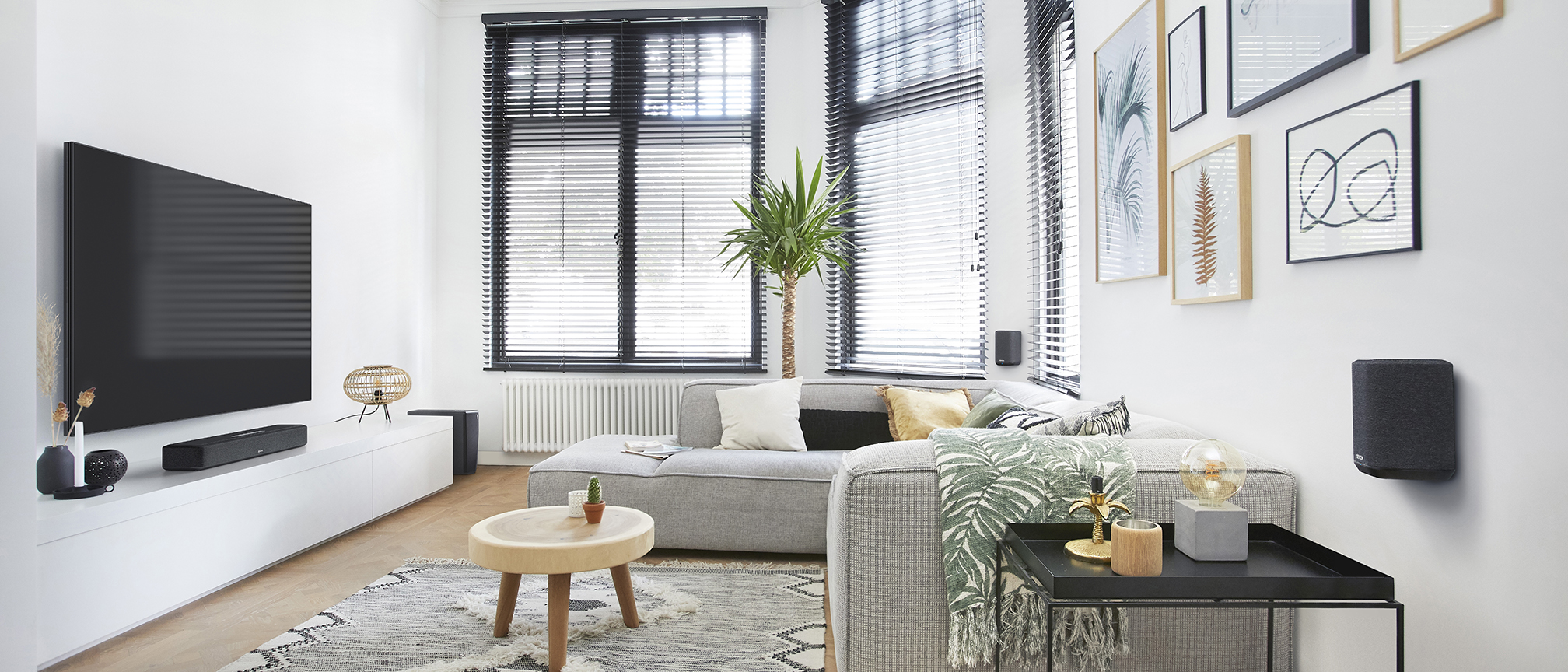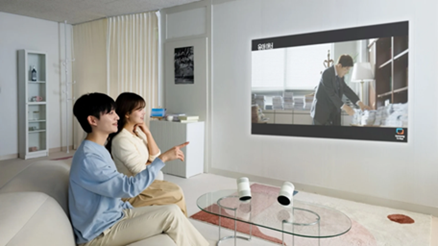Sound+Image Verdict
It’s the versatility which scores here, with a solid soundbar and wireless subwoofer solution plus a pair of streaming speakers which can slot in to deliver full 4.1 surround.
Pros
- +
Easily reconfigurable
- +
Great soundbar performance
- +
HEOS streaming & multiroom
Cons
- -
Some firmware setup issues
Why you can trust What Hi-Fi?
Denon Home Sound Bar 550: £599 / $649 / AU$999
Denon Home 150: £219 / $249 / AU$399
Denon DSW-1H: £599 / $599 / AU$1099
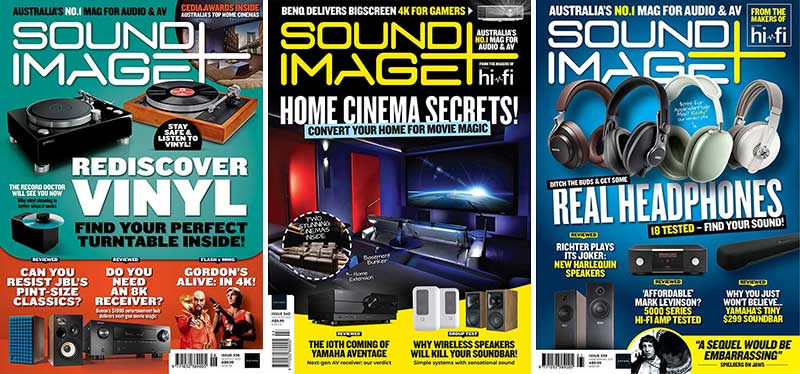
This review originally appeared in Sound+Image magazine, one of What Hi-Fi?’s Australian sister publications. Click here for more information on Sound+Image, including digital editions and details on how you can subscribe.
Denon’s Home Sound Bar 550 is two things. It’s a soundbar, quite a narrow lozenge shape of a bar, the same width as a Sonos Beam but slightly deeper, and taller, at all of 75mm. But it’s also a HEOS speaker, meaning it has the HEOS streaming and multiroom platform inside, which gives app-based access to a variety of music streaming services, also the ability to network with other HEOS speakers through the home, or in the same room.
So with the soundbar we were sent also a pair of Denon Home 150 speakers. These are the smallest of the three standalone wireless speakers in the Denon Home range, all of which we’ve reviewed on their own merits before. These Home 150s came with the soundbar because in addition to being little mono wireless music speakers in their own right, they can be grouped as a stereo pair, so that one plays the left channel and the other plays the right.
Or you can put the two Home 150 speakers behind your listening position and group them with the Sound Bar 550. That creates a four-channel surround system able to play Dolby and DTS soundtracks up to Atmos and DTS:X level, and to provide more expansive sound for music.
One last thing – a Denon DSW-1H wireless subwoofer, which can join the system to provide that ‘0.1’ subwoofer channel to underpin movie soundtracks with real cinematic bass. So how does it all come together in glorious 4.1?
The soundbar
Though we have previously heard all three individual HEOS-equipped wireless speakers in Denon’s Home range, we have not had the pleasure of the Sound Bar 550’s company, so rather than plug up the whole system, we elected to listen first to the soundbar alone. This has one HDMI input to which a source can be connected, an optical audio input too, plus one analogue minijack input and a USB slot which can play files from a stick or drive.
But for our initial set-up we connected only the HDMI output to our TV. With both bar and TV supporting eARC (the enhanced Audio Return Channel), we could then play in stereo or surround from TV to soundbar.
The latest hi-fi, home cinema and tech news, reviews, buying advice and deals, direct to your inbox.
If your TV supports only ARC rather than the new eARC, then you’re probably limited to sending stereo sound this way. Does this make a difference, given that the soundbar operates only in stereo anyway? It has two channels, with a 19mm tweeter at each end of the bar’s frontage (see right), then inside those a pair of 55mm mid/bass drivers for each channel, and then a passive radiator on either side of the iddle. A slightly curious non-symmetrical third passive radiator sits at the back left.
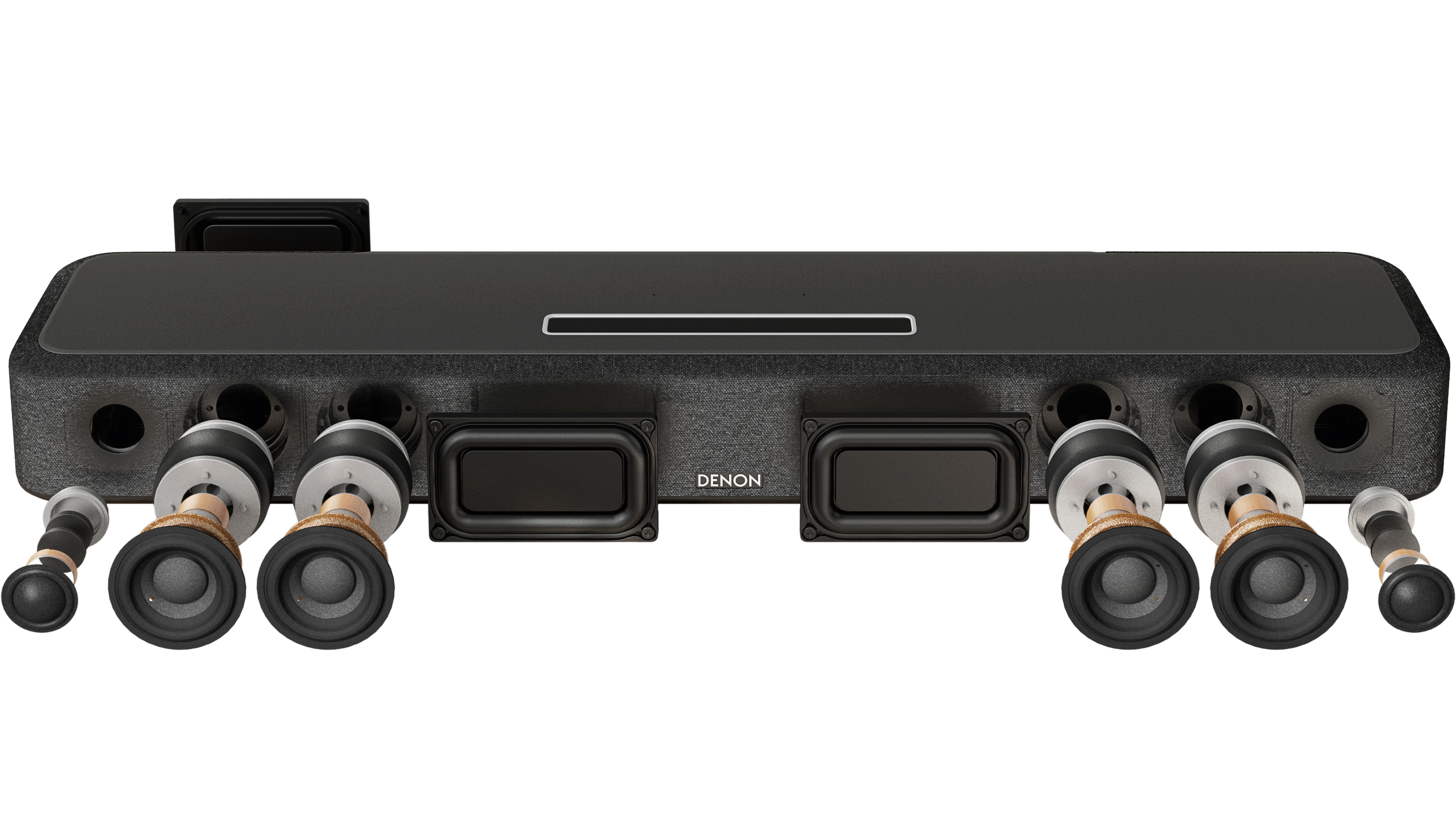
Even though the drivers are configured in stereo, it is possible that the processing used within the bar can achieve better results when given a multichannel signal. The literature implies so, saying that when the bar receives Dolby Atmos content, “the Dolby Speaker Virtualizer function operates automatically, and 3D playback is performed”. There is a similar Virtual:X function for DTS:X content.
You’ll certainly need a multi-channel source signal if you’re planning to go the next step and add those wireless Home 150 speakers for rears. So if you don’t have eARC on your TV, you can give the bar a multichannel signal by plugging a Blu-ray player or media player (e.g. AppleTV) into the bar’s HDMI input, delivering direct a multichannel Atmos or DTS:X soundtrack.
Set-up of the bar uses the HEOS app; this was straightforward enough, and once we had the bar on our Wi-Fi network (Ethernet is also available) we were prompted to make the usual firmware updates – “multiple updates”, it said, warning it could take a while. We left it while the updates were running. Forgot about it, in fact, until later that evening when playing a music video for a guest, playing it loud, thoroughly enjoying it, we realised it was coming from the bar. It sounded exceptional. ‘Go bar!’, we thought.
The next morning we settled into some serious listening, sending the soundbar Atmos soundtracks from Marvel content on Disney+. It performed with a full and spacious sound, solidly underpinned, too, and remember this is without the subwoofer yet unpacked.
It delivered the richness of Tom Hiddleston’s outrageously deep voice in the last episode of Loki, and the deep brass notes through Loki’s closing theme. There was no thinness to big action scenes, no softness to fight sequences – this is the best and certainly the largest soundbar performance we’ve heard from a lone lozenge-type design.
Perhaps we should not have been surprised we were so impressed. Other EISA editors had sung its praises during deliberations for the 2021-2022 EISA Awards, eventually resulting in the ’550 winning EISA’s Smart Soundbar of the Year award. We had been surprised at the time, given it was only a stereo configuration. Now it made sense; this was a great sound.
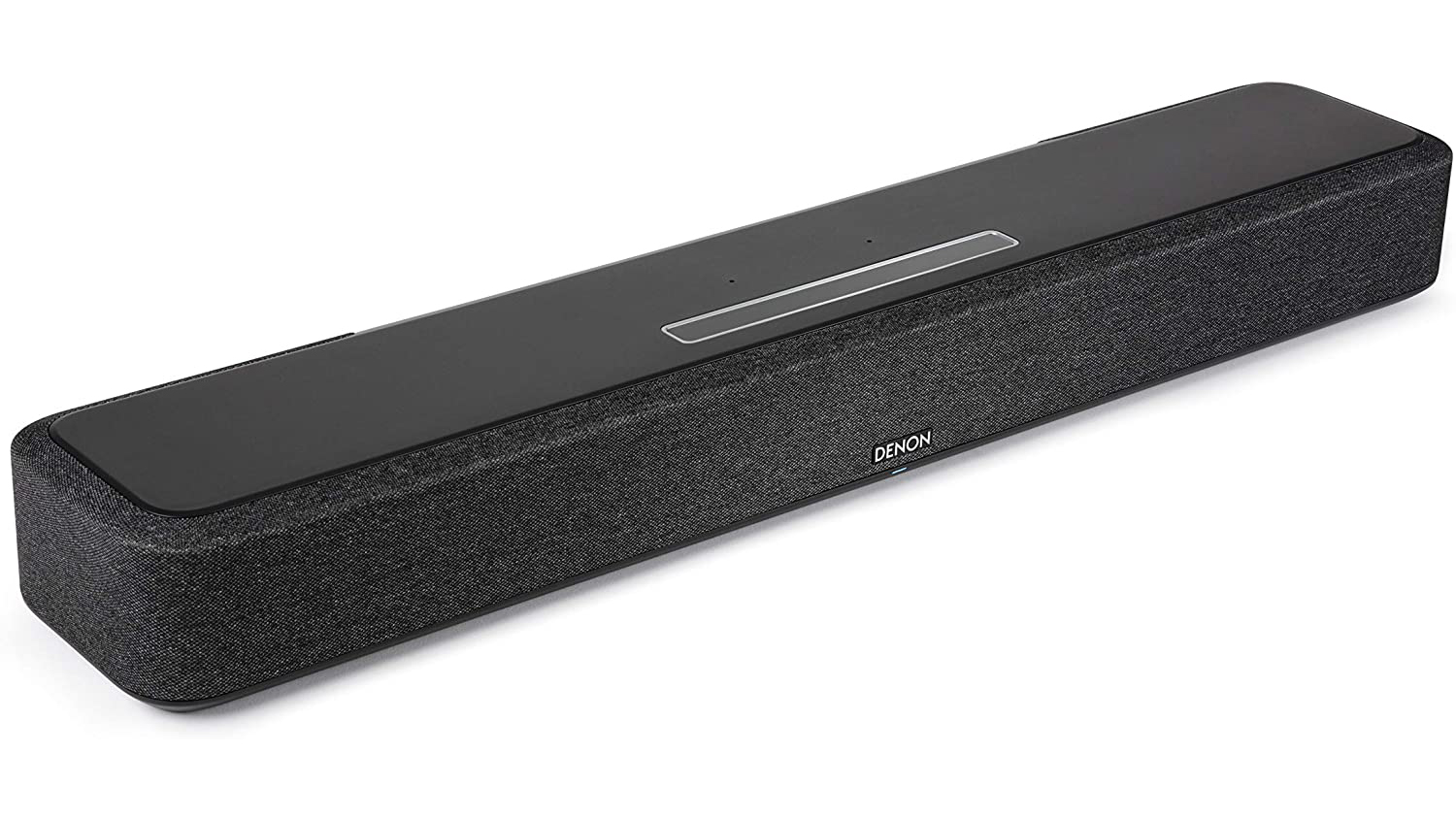
We spent a morning streaming Tidal music via the HEOS app; at times it sounded a little flat, but given a good mix the bar could open up some nice musical pictures, and played musically enough to be enjoyed, if not to truly inspire.
As usual there are various sound options which aim to assist, but which might equally spoil things. With Tidal we did prefer the ‘Music’ option to the thinner ‘Pure’ setting. There’s also a four-position ‘dialog enhancer’ to crisp up dialogue; with TV and movie soundtracks the highest setting lifts speech considerably, but at the cost of a little sibilance.
The ‘night’ setting clears out bass that might disturb the neighbours, but that’s unlikely to be required when using the bar alone. There are simple bass and treble EQ sliders in the app, and bass adjustment buttons on the little remote, though using the remote for these adjustments is hard because there’s no visual feedback. Select ‘Night’ and the bar’s blue LED flashes. Deselect it and it flashes again – but is it off or on? No way to tell. Happily the HEOS app is your friend here, showing all your status choices.
Among all these settings, with a dedicated button on the remote control as well, is one that we suspected might prove useful – ‘Pure’, which the manual describes as “Enjoy sound that is faithful to the original source”. We liked the promise of that. But there was also, in the app, ‘Direct’, which “performs playback of a multi-channel signal without performing virtual processing. This mode can be selected for multi-channel signal input.” We liked the sound of that, too. It was clearly time to add the rear speakers.
Denon Home 150
The Home 150 is the smallest of the three wireless speakers in the Denon Home range. A solid and substantial object, with a 12cm-square footprint and 19cm height, it has the same sturdy fabric wrap as the soundbar, with a screw-threaded mounting hole at the rear should you wish to hang your Home 150s on a wall.
Below that the connections panel offers a minijack auxiliary input, a USB-A slot and the option of Ethernet networking. There are two buttons down there, one to launch Bluetooth pairing, and the other a ‘Connect’ button to connect the Home 150 with your HEOS app.
Were the Home 150’s sole purpose to hang around in the corner of the room corner for a surround soundtrack, then this might seem a tech-heavy anvil to crack a surround-sound nut. But these are neat little wireless speakers in their own right, and can be used individually. So in day-to-day use you could keep one to use in the bedroom, say, and one in the kitchen, with the soundbar on TV duties. Then bring them all together for movie night, grouped into a four-channel system.
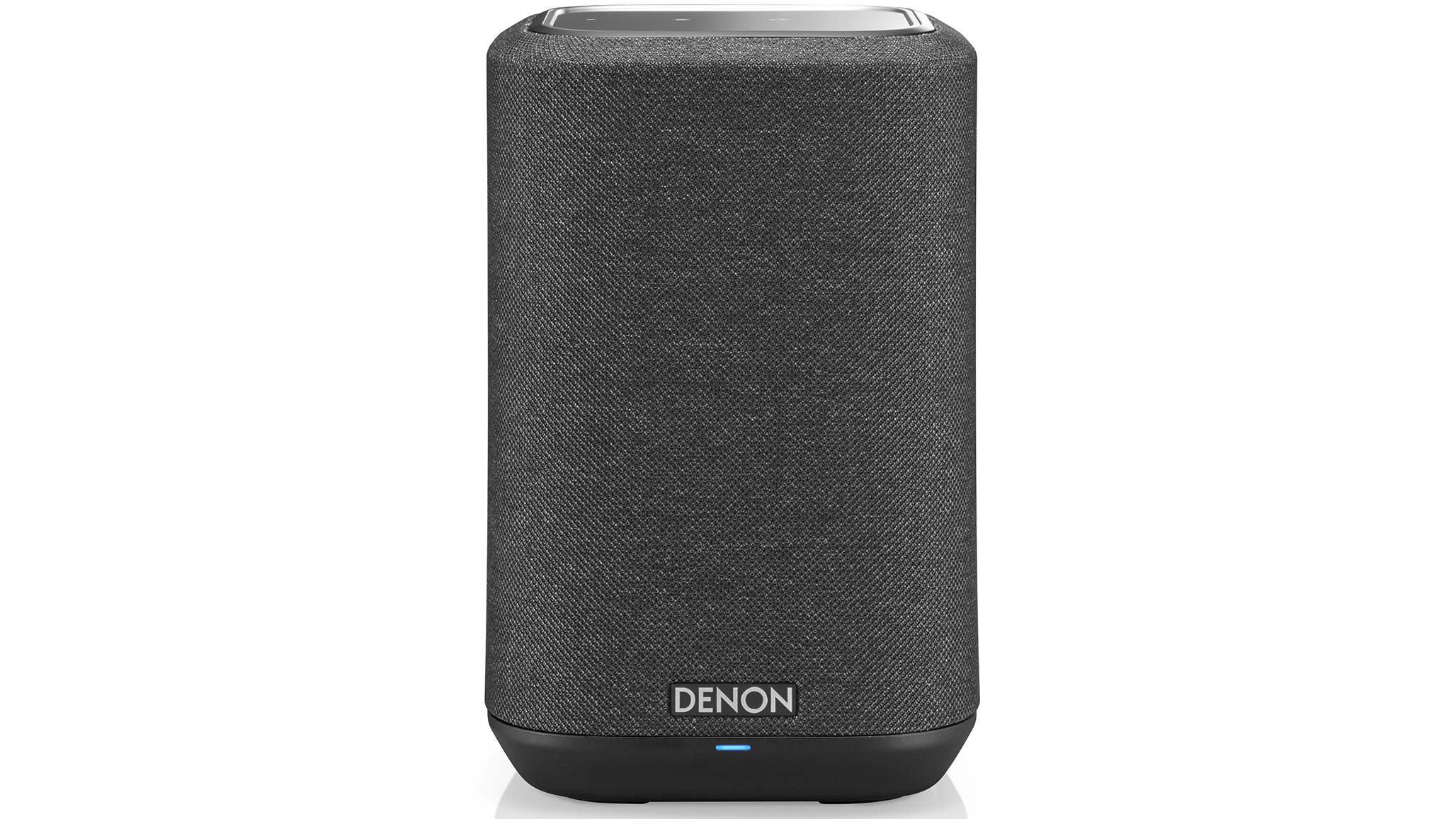
Playing solo, each Home 150 is an impressive little speaker – they’re mono, having a single 25mm tweeter and an 89mm woofer, but with scale and weight beyond the expectations of their size, a remarkably rich sound, even out in free space on a sturdy stand or table. Ultimately in size and power they have their limits, of course, but that point is impressively loud for a speaker so small.
You can also pair them into stereo – still more impressive for music this way, with far more power and energy, and a full stereo spread of music. And if you’re adding Denon’s wireless subwoofer to your TV system, then you could at any time choose to pair that sub to with one Home 150, or with the stereo pair, to fill out this sound still further.
While that sub-sats combo might not be our first choice as a way to spend AU$1897 for stereo music, it’s effectively a freebie, a spare system created by deconstructing your movie system when not in use, while keeping the solo soundbar in the lounge.
The full 4.1
Meanwhile, let’s hear the full monty, pairing the Home Sound Bar 550 (two channels) with both Home 150s (wireless rear channels) and the AU$1099 wireless Denon DSW-1H subwoofer.
This subwoofer is sizable, but can lie flat or stand vertically, its design harking back to the former HEOS speaker range, and its depth coming from dual custom 133mm drivers and an unspecified Class-D amplifier within.
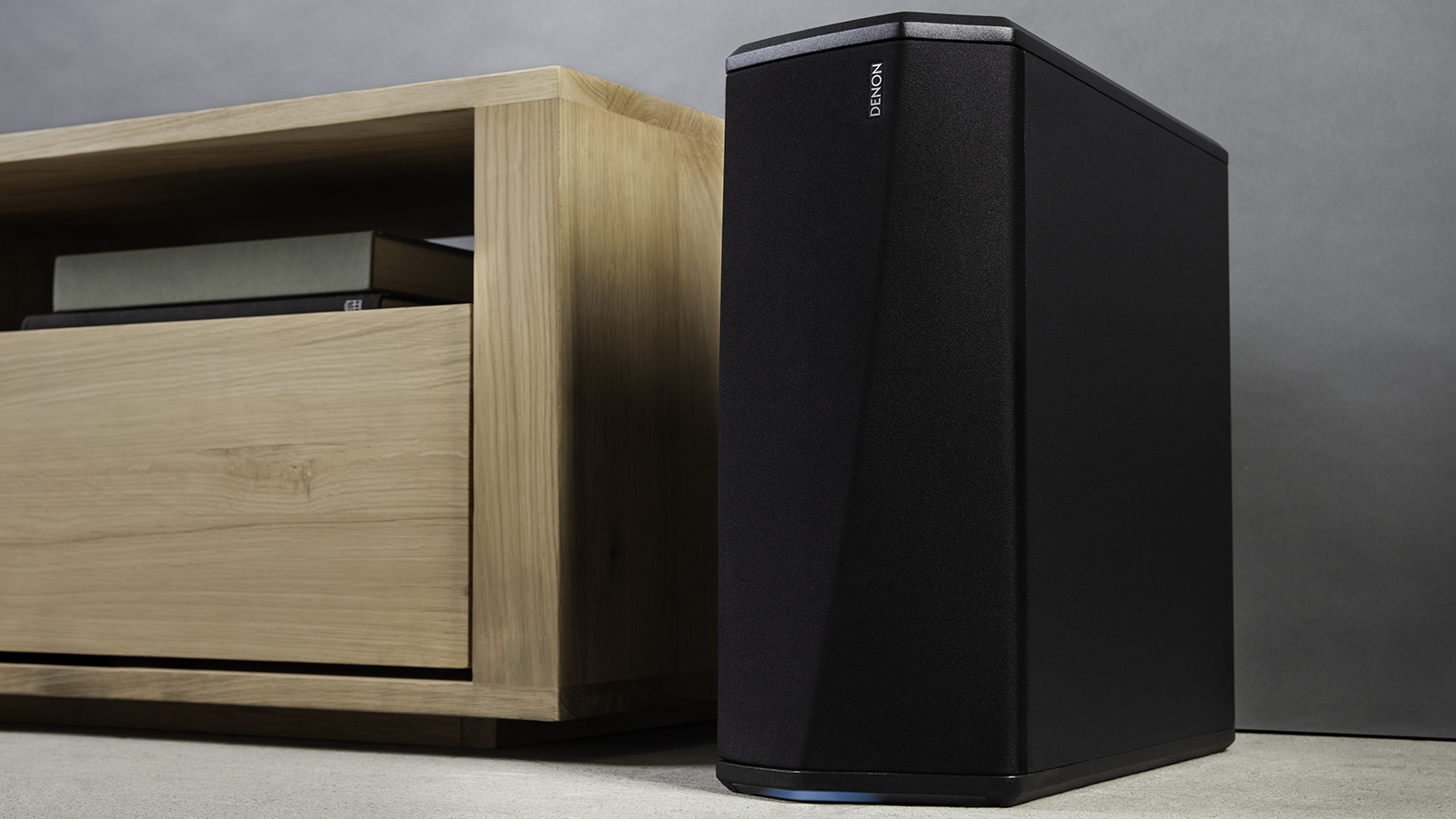
We confess we had problems pairing all these up into one system; the pairing failed repeatedly, because (it turned out after many hours) the units weren’t all on the same firmware. Yet they’d all received an update, and the HEOS app was telling us everything was up to date.
By repeated attempts we got the Home 150s to update, and the subwoofer updated itself overnight when we left the ‘auto update’ option. So our advice if this happens to you is to give up, go to bed, and try again in the morning! Our advice to Denon’s HEOS crew (which coordinates the HEOS world from Sydney) would be to make their app a little smarter at resolving such problems.
The next day, however, Atmos soundtracks flowed freely from the TV down eARC to the Home 550 Sound Bar, which wirelessly shared them with the rears and subwoofer. The HEOS app allows adjustment of distances and levels, even the crossover frequency.
As the front bar doesn’t push sound sideways in any particular manner, it makes sense to put the rears wide, and this delivered a fairly immersive soundfield with Disney+’s Jungle Cruise, the rear atmosphere awash with toucans and water swooshes, while the subwoofer made itself known under the throaty growl of Frank’s pet jaguar, the torpedo explosion, the river rapids, and plenty more.
But subwoofers and rears are for more than special effects; they also opened and strengthened the sound throughout, deepening voices and gunshots, opening up atmospheres and more, though we should note that Atmos soundtracks only ever emerged from front and rear; there was no magically processed height, nor much width, delivered by the soundbar.
We confess we deliberately ran the rears a little hot, pushed up to accentuate the surround; it may not be entirely correct, but it can be more fun. Conversely we levelled the subwoofer where we could just hear it, which is less intrusive.
This was a good recipe for surround music too, though we brought the rears back to parity with the front. Surround music in Atmos is now available from Apple Music and Tidal, while any number of DVDs and Blu-rays will deliver surround music in various formats. We enjoyed the latest Atmos mixes of The Beatles ‘Let It Be’, and then our favourite, the soundtrack to ‘Love’, its rear content swirling behind us, and a good amount of level available.
Final verdict
The Denon combo doesn’t rival a proper surround system, and even if all you want is a soundbar system with wireless rears and subwoofer, we’d probably point you elsewhere.
But what makes Denon’s Home combo so impressive is its versatility. Today it’s a surround system, tomorrow it’s a multiroom system that the whole family can use, the next day you can have two Home 150s in stereo with a subwoofer.
All of these enjoyable systems can be regrouped at will using the app, and all provide a high quality of entertainment, backed by the powerful HEOS platform’s access to streaming and networked music, including AirPlay streaming and Alexa voice control via built-in microphones. It’s fun for all the family.

Jez is the Editor of Sound+Image magazine, having inhabited that role since 2006, more or less a lustrum after departing his UK homeland to adopt an additional nationality under the more favourable climes and skies of Australia. Prior to his desertion he was Editor of the UK's Stuff magazine, and before that Editor of What Hi-Fi? magazine, and before that of the erstwhile Audiophile magazine and of Electronics Today International. He makes music as well as enjoying it, is alarmingly wedded to the notion that Led Zeppelin remains the highest point of rock'n'roll yet attained, though remains willing to assess modern pretenders. He lives in a modest shack on Sydney's Northern Beaches with his Canadian wife Deanna, a rescue greyhound called Jewels, and an assortment of changing wildlife under care. If you're seeking his articles by clicking this profile, you'll see far more of them by switching to the Australian version of WHF.
